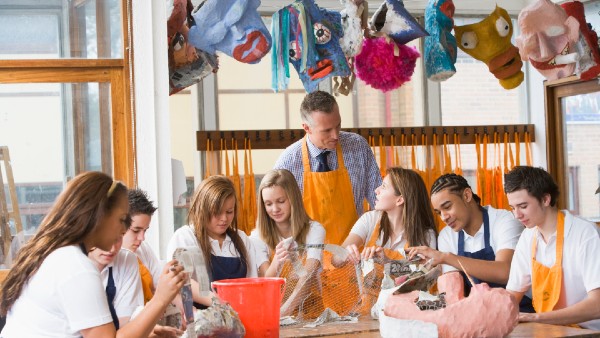The RSA’s final report on the Learning About Culture project is published today. It explores what we can learn from the five evaluations of arts and cultural activities in schools commissioned by the RSA and the Education Endowment Foundation, and the RSA’s work to support evidence-rich practice in arts-based education.
We began the Learning About Culture project in 2017, interested to discover if we could help improve access to the arts by demonstrating how they make a difference to academic attainment. Improving attainment isn’t always the focus of arts-based learning, but it is claimed by many advocates, and practitioners often expect it to happen, even if it is not the specific intention of their activity.
These expectations of impact are largely based on correlational studies that identify a relationship between arts participation and improved academic performance, but don’t imply causality. That is: they show that doing well in school and taking part in the arts often coincide, but don’t provide evidence that participating in the arts was the cause. In the context of an ongoing decline in access to arts teaching and qualifications and inequitable access to arts education, it’s not entirely surprising that any favourable evidence becomes part of the advocate’s arsenal.
The five activities evaluated as part of Learning About Culture were delivered at a scale far larger than most arts organisations usually operate, in order to give us the best chance of getting a clear indication of their impact. However, the results show that it continues to be difficult to achieve certainty about a causal relationship between arts-based learning and academic outcomes, even when evaluating at scale.
The evaluations did produce encouraging evidence of impact on outcomes that were ‘secondary’ in this study, but which are closer to the goals of many practitioners. Whether in social skills, self-efficacy or ‘ideation’ (the ability to express one’s ideas) there is evidence here for the potential of arts-based learning activities in Key Stage 2 to make a difference. However, the trials did not produce statistically significant evidence that the activities evaluated raised attainment in English. To be clear – participating in arts-based learning didn’t get in the way of attainment, it just didn’t raise attainment higher than the approaches schools might otherwise have taken.
This isn’t unusual: raising attainment is a high bar to clear and it’s rare to see it with educational interventions of any sort (i.e. not just arts-based interventions) evaluated in this way. It’s also not surprising: these results are in line with previous research (including the EEF’s own systematic review of evidence) and in line with what many practitioners expect – impact on attainment is rarely a success criterion for arts-based learning and most expect the benefits to lie elsewhere. In addition, since we began this project in 2017, the context has changed considerably: a new Ofsted framework for assessing schools in England, which prioritises curriculum depth and breadth; a post-Covid situation in which attendance to pupils’ wellbeing has come to the fore.
With those factors in mind, perhaps the overriding lesson of these trials is that it’s time to put to bed attempts to hold the arts accountable for impact on attainment, or to advocate for the arts based on claims of impact in that area. The evidence is not compelling, getting compelling evidence is an ongoing challenge and it’s increasingly less important in making the case for the arts in education.
For the RSA, this can only be a positive step. The RSA’s Fair Education programme is based on a premise that the purposes of education are three-fold:
1. Capability: Education should help children develop a wide range of knowledge and skills that endow them with cultural capital and prepare them for life and work.
2. Agency: Education should develop the motivation and wherewithal to be in command of one’s own life; to be deliberate and purposeful in participating in and driving social change.
3. Community: Education should serve to strengthen communities, help them to overcome disadvantage and develop understanding of our shared and distinctive cultural heritage.
The findings of the Learning About Culture evaluations – not least the promise of impact on a wide range of outcomes – reinforce the RSA’s belief that the arts have a role to play in all three areas of purpose. They also suggest that the focus of future evaluation should be the more obvious, more intentional outcomes, sought by practitioners and participants in arts-based learning. This would have the double benefit of emboldening the evidence culture in the sector and helping articulate how the arts contribute to an education that supports all children to flourish. As we improve our understanding of these outcomes are produced, it may also open new avenues for understanding how they influence more general outcomes, like academic attainment.
Richer dialogue between the arts sector, schools, policymakers and funders becomes possible when arts-based learning providers demonstrate concern for both pupil outcomes and equitable access to the arts but do not conflate the two. Acknowledging gaps in understanding of how the arts contribute to improved outcomes, but also accepting limitations on where it might contribute helps make the sector more credible. Otherwise, we end up in a situation where advocacy is based on arguments “by people who don’t believe them, to people who don’t believe them” and misses the opportunity to find convergence on outcomes of mutual interest.
Our final report provides a summary of and response to the EEF-published evaluation reports. In addition to detailed suggestions of what practitioners in the education and cultural sectors can learn from these evaluations, our paper makes three high-level recommendations for policymakers and practitioners.
1. Schools should maintain an arts-rich curriculum
The evaluation results indicate that teaching through the arts does not get in the way of children’s progress in literacy. In addition, arts-based approaches provide children and teachers with many other benefits, only some of which are linked to attainment. Doing the arts well in school depends on school-wide commitment, championed at senior leadership level.
2. Advocacy for the arts in education should build on moves in education policy that encourage breadth and balance, rather than focus on generalised claims of impact on attainment.
Impact on pupil attainment isn’t the main reason why schools and cultural sector practitioners provide arts-based learning. The results of the LAC trials leave us no more certain about a causal relationship between arts participation and improved attainment and suggest that making the case for the arts in schools based on impact on attainment can be confusing for schools. In the context of policy moves towards a broader scope for assessing the quality of school curricula and in the post-Covid context where interest in pupil wellbeing has come to the fore, the importance of demonstrating impact on attainment is waning.
3. Funders of arts-based education should support and encourage stronger relationships between practitioners and the research and evaluation community.
Arts-based learning is often expected by practitioners to facilitate, rather than be the direct cause of improvements in educational outcomes, but this process is not well-enough understood. More research is needed to understand how and when arts-based approaches create a supportive context for improved educational outcomes. Engagement between the practice and research communities can lead to mutual learning and better designed activities, but practitioners can feel intimidated in the unfamiliar milieu of research.
Related articles
-
We need to teach children new forms of literacy
Comment
Lazar Dzamic
Knowing how to read and write is no longer enough. Lazar Dzamic argues that we need to arm our young with new literacies, to fight narratives sold by media, politicians, religion, the entertainment industry and big business.
-
Artificial intelligence: the creative edge
Comment
Alex Soulsby
How should schools respond to AI? Alex Soulsby calls for a greater focus on the arts to help students develop their creativity, critical thinking, adaptability and emotional intelligence.
-
Invitation: Philanthropic networking event
Fellowship news
Innovation professional Jess Denny FRSA invites London Fellows to a philanthropic networking event at The Steps in the RSA House.




Join the discussion
Comments
Please login to post a comment or reply
Don't have an account? Click here to register.
This makes very interesting reading and I hope that the further research is done . I am sure that covid has highlighted the role that Arts play in our personal wellbeing and feeling good certainly puts you in the frame of mind to learn better and more. Arts in the working environment shared and enjoyed by teams I am sure leads to better outcomes. Anecdotal I know but lets continue the research to authenticate. It is also important to acknowledge the role the arts play for adult learners of all ages. As a scientist and educator I studied textiles when I retired and now exhibit around the world. this brings joy, calmness and networking while a carer. I would have had the arts more prominent in vaccination centres. Often rules with no foundation are barriers... Its great to see where minds are opened.
Did you consider the impact of creative problem-solving applied across the curricula? the range of creative methodologies widely practised through the art and design offerings of universities and foundation-courses surely is a transferable skill essential to all strategies of self-learning/lifelong learning, let alone other aspects of the design process?
Inevitably, there is a lot that was outside the scope of this research! Your comment points to something that the evaluators did observe, however. We evaluated the impact of arts-based education projects on literacy outcomes. The causal link isn't immediate, but influenced by a range of hypothesised 'active ingredients' (of which creative problem solving could indeed be one). Where we were unable to observe an impact of these activities on literacy, it's difficult to know if that's because these activities don't reliably produce the required active ingredients, or that the active ingredients don't reliably improve literacy. If we want schools to use arts-based learning to improve outcomes in other areas of study, research needs to be focused on understanding these causal links.
As a former FE College Lecturer, I am not surprised by the conclusions arrived at after 4 years of research. I welcome the refreshing honesty of the conclusions, as they indicate that attainment of high/er academic results is NOT linked to arts-related activities. Education is about the Latin concept of ēdūcere, present active infinitive of ēdūcō ("I lead, draw or take out, forth or away").[Source: https://www.wordsense.eu/educere]. In this real sense, the arts may not contribute much towards present day goals of high/er academic achievement but they can definitely contribute towards future achievements long after individuals are no longer at school, college or university. Has this been considered?
Thanks, John. We didn't look at how participating/ learning in the arts in school contributes to later life outcomes, but certainly others are doing this (e.g. https://www.artscouncil.org.uk/children-and-young-people/long-term-research-0#section-2). There is plenty of evidence to indicate that there is a link between arts participation and higher attainment - but not that doing the arts LEADS TO higher attainment. While we found lots of positive outcomes, our evaluations did not find any significant evidence to challenge that.
My concern is this. Why this desire to prove any relationship between arts ( creative learning) and academic achievement ? Why should there be one? I addressed an art seminar in Fabriano(Italy) yesterday and this very issue came up. Question; ‘Shouldn’t children be taught to read and write , to be proficient in arithmetic, first of all, and creative pursuits be ( I presumed) some sort of add on? This merely indicated to me the perennial misunderstanding of what an art and creative education is about. My response to the questioner was that should creativity on our planet be absence for just one day, that it would darken, implode and spiral into the sun. Meaning of course, that if pressure on a child to achieve and excel academically is ramped up at the expense and balance of creative expression, then look around. You get what you planned for, a soulless, consumer fixated way of life, bereft of any love of nature and of the beauty of poetry, music, and the freedom to imagine and dream. At the very least, I proposed, education should be an equal balance between the academic and the creative. allowing, always, the desire of a child to shift, even partially, towards one direction or the other, should his or her nature suggest.
I think you're absolutely right. There needn't be a connection. Our study responded to a) the fact that some advocates for the arts in schools claim a causal connection and b) an indication that a fixation on attainment in the education system (especially in England) seems to have caused some schools to decrease their provision in the arts. We found that arts-rich education doesn't stand in the way of children's attainment, even if we don't have compelling evidence that it improves it. But we also found that if we really want to understand the value of the arts in school and how to do them well, we need to move away from holding them accountable for things that are difficult/ impossible to evidence and contrary to the expectations of practitioners.